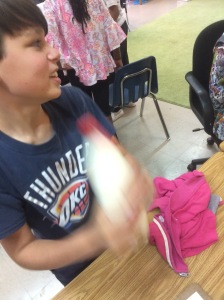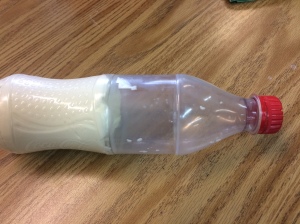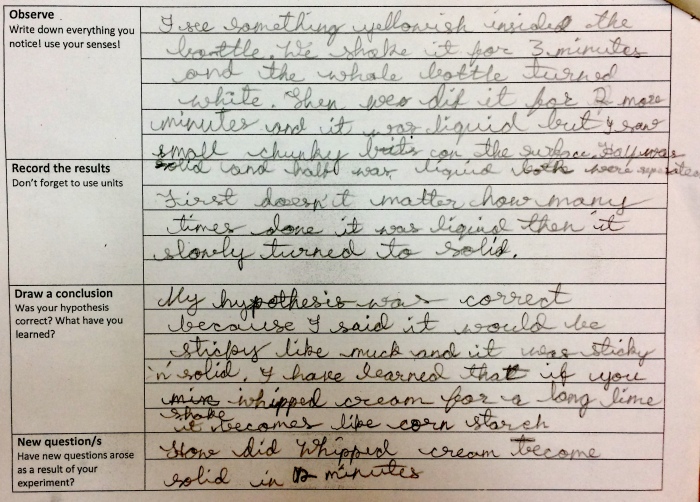For the summative task of our recent Unit of Inquiry (“Matter and Materials”) I wanted to get students engaged in a fun hands-on experiment.
One of my colleagues suggested I do the “Cream to Butter” experiment (OK, I made up the name…). After researching the experiment and seeing the wonderful possibilities, I decided to take it on. I quickly created two documents- an experiment documentation sheet and another document with more general questions about separating materials.
Below is the process of our lab in the form of a lesson plan. I hope you find it interesting and use it in your own classroom:
Materials (per group):
- A box of whipping cream (some room temperature and others fresh out of the fridge)
- An empty bottle
- A measuring cup
- A timer
- A pair of scissors
- Scales
- A thermometer
- The lab sheets (the one with general questions I used is definitely optional)
Tuning-In:
- Ask the students what they know about separating materials (methods, tools, results, etc.)
- Show them the box of whipping cream. Ask them if they know what it is, what people do with it, and what the ingredients are. Then, ask them if they think they can separate what’s inside the cream.
- Brainstorm ideas as to how they could separate it.
- Tell students that today they will try to separate the whipping cream by shaking it (it is called “churning”, which is the process of shaking up cream or while milk to get butter).
The Experiment:
- Preparation:
- Divide the students into groups of 4-5 students.
- Each group should get the materials listed above.
- Have the students cut the cream box, pour it into the empty bottle, and wait.
- Once all groups finished, make sure the bottle caps are screwed on tightly.


- Documentation:
- Go over the experiment sheet and make sure all students know what to write in each step.
- Give students time to fill out the first part of the sheet:
- The question (“what happens if I shake a bottle full of whipping cream?” and “is it possible to separate whipping cream by shaking it?” are two good examples for student questions.
- The Background Information (they should write what they know about whipping cream and about separating materials by shaking them)
*** Their Hypothesis (“It will separate”) should not suffice. Make sure they are specific in their explanation, and that they don’t use words such as “it” to describe the bottle or the cream.
- Once all students are done, go on to the next step.

- The Experiment: (Basically, students will be shaking the bottle continuously until it completely separates. It will separate into a solid (butter) and a liquid (buttermilk), but don’t tell them yet…)
- Students will take turns shaking the bottle. Every one minute, they will change “shaker”.


- After every 3 minutes (we went up to 18 minutes for the room temperature cream groups), they will stop the shaking and record their observations in their sheets. Remind them to use their senses and be as accurate as they can in their observations and records.
- When they are done recording, they should continue the timer and the shaking.
- After about 9 minutes, the cold whipping cream groups should have a solid (the butter) and a liquid (the buttermilk) clearly separated in their bottle. That’s pretty much the end of their experiment. They should now pour the liquid into the measuring cup, and complete the Observation section as well as the “Record the Results” section. They should spend ample time and effort on this part, continuing to observe and think of ways to describe their final product. Remind them that they might want to use the scale and the thermometer you gave them. How? They should think carefully.




- The room temperature group will continue to shake their bottles and record their observations every 3 minutes. You should stop them at about 15 or 18 minutes because it might just not separate…

At this point we ended the work for the day and stretched a bit. Rigorous shaking can be hard on 10 year olds…
- Discussion:
- Once they are all done filling out the entire sheet, discuss with the students what they did, what they noticed, and ask them why the cream of some groups did not separate (because of its temperature).
- Ask students if they think this separation was a physical or a chemical reaction and why (it was a physical reaction, because indeed, the process can be reversed!)
- Have students share the last question “New Question/s” as ideas for a follow-up experiment.

*** Extension: If the question did not come up, ask them if they think the room temperature cream could still be separated if it is now placed in the fridge (it won’t, according to our experiment…). Placing some in the fridge and others leaving out could be another experiment, introducing concepts such as independent and controlled variables.
Celebration:
- Another exciting part of this experiment is the fact that the product of their separation is completely edible!
- Bring some bread and jam, and have some fun!
Learn more about the experiment:

No comments:
Post a Comment